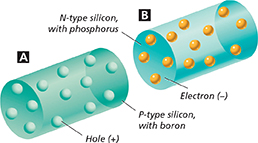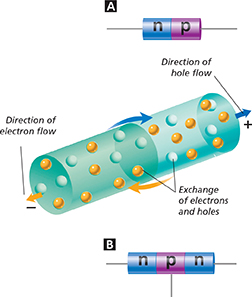Semiconductors
A semiconductor is a crystalline solid that conducts current only under certain conditions. Most semiconductors are made with silicon or germanium. In pure form, these elements are poor conductors. But when trace amounts of other elements are added, it becomes possible to control the current inside of the crystals. Figure 19 shows two types of semiconductors.  In n-type semiconductors, the current is a flow of electrons. In p-type semiconductors, it appears as though positive charge flows.
In n-type semiconductors, the current is a flow of electrons. In p-type semiconductors, it appears as though positive charge flows.
A p-type semiconductor can be made by adding a trace amount of boron to silicon. In Figure 19A, you can see spaces, called holes, at each boron atom. The holes are positively charged. Figure 19B shows an n-type semiconductor made by adding phosphorus to silicon. Phosphorus atoms provide weakly bound electrons that can flow.
By themselves, n-type and p-type semiconductors cannot do much. But when joined together, electrons in the n-type semiconductor are attracted toward the positively charged holes in the p-type semiconductor. As electrons jump from hole to hole, it looks like a flow of positive charge because the locations of the holes change.
Figure 19 A semiconductor becomes a good conductor of charge if trace amounts of elements are added to it.

Solid-State Components
Semiconductor devices were first used in the late 1940s. These devices were named solid-state components because they used solids rather than vacuum tubes to control current.  Most modern electronic devices are controlled by solid-state components. Three of the most useful solid-state components are diodes, transistors, and integrated circuits.
Most modern electronic devices are controlled by solid-state components. Three of the most useful solid-state components are diodes, transistors, and integrated circuits.
Diodes
A diode is a solid-state component that combines an n-type and p-type semiconductor. When a voltage is applied across a diode, electrons flow from the n-type to the p-type semiconductor. There is no current if voltage is applied in the opposite direction. Because the current can be in only one direction, a diode can change alternating current to direct current.
Transistors
Figure 20B shows a transistor, a solid-state component with three layers of semiconductors. A small current flowing through its center layer changes its resistance. A transistor can be used as a switch because the small current can turn another current on or off. It can also be used as an amplifier. A small voltage applied to one side of the transistor produces a large voltage on the other side.
Figure 20 A A diode is two different semiconductors joined in one component. B A transistor is three semiconductors with the middle one different from the outer ones. Applying Concepts In addition to the arrangement of the transistor in B, how else might you arrange the transistor?
 d
d



